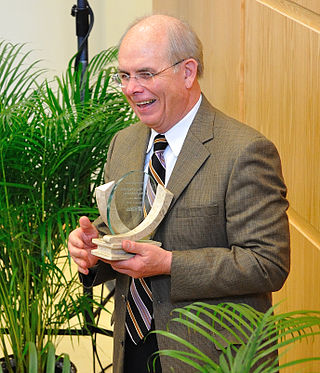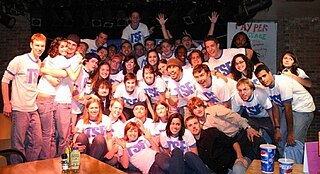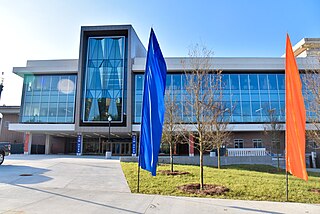
The University of Florida is a public land-grant research university in Gainesville, Florida. It is a senior member of the State University System of Florida. The university traces its origins to 1853 and has operated continuously on its Gainesville campus since September 1906.

Florida Blue Key is a student leadership honor society at the University of Florida. It was founded in 1923. The organization is the oldest and most prestigious leadership honorary in the state of Florida. Members include notable politicians and prominent business leaders. Florida Blue Key recognizes a class of students each semester who have displayed exemplary leadership on campus and have made significant contributions to the University of Florida through service.

The Independent Florida Alligator is the daily student newspaper of the University of Florida. The Alligator is one of the largest student-run newspapers in the United States, with a circulation of 14,000 and readership of more than 21,000. It is an affiliate of UWIRE, which distributes and promotes its content to their network.

James Bernard Machen is an American university professor and administrator. Machen is a native of Mississippi, and earned several academic degrees before becoming a university administrator and president. Machen had been the president of the University of Utah in Salt Lake City, Utah and the University of Florida in Gainesville, Florida. He also sits on the Sanford-Burnham Medical Research Institute's Board of Trustees. On June 8, 2012, Machen announced he would be stepping down as president in 2013. However, Machen was asked by state and university leaders to stay on, as the school had not yet found a suitable replacement. He was finally succeeded by W. Kent Fuchs on January 1, 2015.
Marshall McAllister Criser, Jr. is an American corporate lawyer and former university administrator. Criser is a native of New Jersey, and earned his bachelor's and law degrees before becoming a practicing attorney. He was the eighth president of the University of Florida, serving from 1984 to 1989.

Buckman Hall is a historic building located in Murphree Area on the University of Florida campus in Gainesville, Florida, United States. It was designed by architect William A. Edwards in the Collegiate Gothic style and opened in 1906 as one of the two original buildings on the University of Florida's Gainesville campus along with nearby Thomas Hall. It once was a multi-purpose facility but has been used exclusively as a student dormitory since the 1940s.
Murphree Area is an historic residence hall complex on the northern edge of the University of Florida campus in Gainesville, Florida. The complex is adjacent to University Avenue, one of the major public roads that serve the university and define its boundaries. It was the university's first residence area and the last one to become co-ed. The Murphree Area complex is named for Albert A. Murphree, the second president of the university, who served from 1909 to 1927. It consists of the following five residence buildings, all built between 1905 and 1939:

The Florida Gymnasium is a historic building located on the campus of the University of Florida (UF) in Gainesville. It opened in 1949 as a 7,000-seat multi-purpose arena and served as the home court of the Florida Gators men's basketball team and other UF indoor sports programs for over thirty years, acquiring the nickname of "Alligator Alley" during that time.

The University of Florida Institute of Food and Agricultural Sciences (UF/IFAS) is a teaching, research and Extension scientific organization focused on agriculture and natural resources. It is a partnership of federal, state, and county governments that includes an Extension office in each of Florida's 67 counties, 12 off-campus research and education centers, five demonstration units, the University of Florida College of Agricultural and Life Sciences, three 4-H camps, portions of the UF College of Veterinary Medicine, the Florida Sea Grant program, the Emerging Pathogens Institute, the UF Water Institute and the UF Genetics Institute.

Fletcher Hall, originally called North Hall, is a historic dormitory building on the campus of the University of Florida in Gainesville, Florida, United States. It makes up half of the "F" in the "U.F." in the Murphee Area. The "U.F" in the building design can be seen from an aerial view. It was designed by Rudolph Weaver in the Collegiate Gothic style, was built in 1938 and was named for Duncan U. Fletcher, longtime U.S. Senator from Florida. It was renovated in 1984.

Theatre Strike Force is the University of Florida's premier improv and sketch comedy troupe. The group also goes by TSF. The style of improv performed by Theatre Strike Force is a combination long form and short form. They both teach and perform improvisational comedy. They have six house teams which include both forms of improv as well as a sketch team. There are four long form house teams which are cast every semester and usually have six to eight members. The TSF Short Form Team is cast every semester as well and usually has fifteen to nineteen members. TSF Sketch is the final house team and usually has twelve to sixteen members, cast each semester.

Stephen Cornelius O'Connell was an American attorney, appellate judge and university president. O'Connell was a native of Florida, and earned bachelor's and law degrees before becoming a practicing attorney. He later was chosen to be a justice of the Florida Supreme Court from 1955 to 1967, and served as the sixth president of the University of Florida from 1967 to 1973.
Alfred Coard "Al" Warrington, IV is a former American accountant and business executive. Warrington was a managing partner of Arthur Andersen and the co-founder of Sanifill, Inc., a company which ultimately merged to create the new Waste Management, Inc. Warrington is an alumnus and significant benefactor of the University of Florida, and has held various positions in the governance of the university and its related organizations.

The J. Wayne Reitz Union is the student union of the University of Florida, located on Museum Road on the university campus in Gainesville, Florida, United States. The union was named in honor of J. Wayne Reitz, the fifth president of the university, who served from 1955 to 1967. The building, which was originally completed in 1967, contains dining facilities, meeting rooms, offices, a computer lab, a game room, an outdoor amphitheater, retail stores, a movie theater and a hotel.

The Infirmary, now known as the Student Health Care Center, is a historic building on the campus of the University of Florida in Gainesville, Florida in the United States. It was designed by Rudolph Weaver in the Collegiate Gothic style and built in 1931. Since 1983, it has served as a student outpatient clinic.

The Hub is a historic building on the University of Florida campus in Gainesville, Florida in the United States. It is located on Stadium Road between Buckman Drive and Fletcher Drive.

The Yulee area is a historic residence hall complex at 13th Street and Inner Road, SW, on the University of Florida campus in Gainesville, Florida in the United States. It is the site of the first permanent dormitories built for women after the campus became co-educational in 1947. On June 24, 2008, it was added to the National Register of Historic Places.

The history of the University of Florida is firmly tied to the history of public education in the state of Florida. The University of Florida originated as several distinct institutions that were consolidated to create a single state-supported university by the Buckman Act of 1905. The oldest of these was the East Florida Seminary, one of two seminaries of higher learning established by the Florida Legislature. The East Florida Seminary opened in Ocala 1853, becoming the first state-supported institution of higher learning in the state of Florida. As it is the oldest of the modern University of Florida's predecessor institutions, the school traces its founding date to that year. The East Florida Seminary closed its Ocala campus at the outbreak of the American Civil War and reopened in Gainesville in 1866.
Carlos Juan Alfonso is a Cuban-American architect and former chairman of the University of Florida Board of Trustees and member of the Florida Constitution Revision Commission. He is a founding principal and president of an architecture firm located in Ybor City, Florida. In addition, he founded Alliant Partners LLC, a commercial real estate investment company. He currently serves as CEO for both companies.

The University of Florida Inter-Residence Hall Association (IRHA) is a student organization of the University of Florida that acts as an association of on-campus undergraduate residents and represents them to the university housing department. IRHA is a residence hall association (RHA) and is the exclusive such organization for University of Florida undergraduates. The organization is one of the largest student organizations on campus and, historically, one of the most influential on university policy.
















